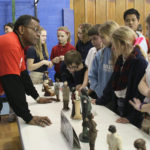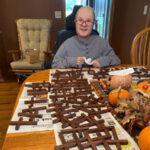By Patrick Schmadeke
Evangelization in the world today

Springtide Research Institute studies the intersection between religious and human experience of 13- to 25-year-olds. As part of its research, Springtide articulates what it calls “the belongingness process.” This is a three-fold deepening, where someone feels noticed, named, and known. “These experiences build on one another to deepen the overall experience of belonging.” Many of the practices that parishes in our diocese have taken up over the past year to focus on welcoming and belonging map onto that framework. Those practices in our parishes include the following:
Feeling noticed. Personal or individual practices for encounter include cinnamon roll Sunday after Mass, providing welcome bags for new members and guests, and training greeters to engage people they don’t know in a warm, friendly way at every Mass. More general communication strategies include inviting people from the surrounding community to events, not just active parishioners, and providing liturgically relevant activities or resources for young children to use during Mass. Other ideas include welcoming signage and inviting visitors to be recognized in a small way at the end of Mass. Practices such as these can help people feel that their presence is acknowledged and that their needs are being met in some basic way.
Feeling named. Personal or individual practices for encounter include greeting by name those around us before Mass begins, offering a monthly nametag Sunday and hosting gatherings such as a movie night at the parish. More general communication strategies include updating the parish directory, having ushers wear nametags and featuring different community members (e.g. new members) on the parish social media page, website, and/or bulletin board. Also, offering monthly recognition of parishioners’ birthdays (e.g. in the bulletin) and sharing short videos of parishioners telling their faith story on social media. These kinds of practices convey the community’s commitment to learning someone else’s name.
Feeling known. Personal or individual practices for encounter include sending thank you notes to different ministers in the community such as music ministers, lectors, greeters, pastor, catechists, etc. Small groups/faith sharing groups can extend personal invitations to an event. The parish can host new member meals, a picnic or soup supper, a book study or social gathering for parents during their children’s faith formation program. Call to check in on sick parishioners who can’t make it to the church building. Organize parish service projects. More general communication strategies could include responding to the language needs of various cultures in the community.
Institutional practices that parishes can take up include collaborating with other parishes, updating parish websites and bulletin boards, making sure buildings are accessible and providing sacramental policies that are clear and accommodating. Brighten up and declutter the church entryway, revisit the parish’s mission statement to ensure it is welcoming. Create a community calendar for the parish. Involve young people regularly in liturgical ministries. Offer intergenerational Advent and Lenten retreats that include religious education students. Offer homilies about welcoming and belonging. Provide parish ministers’ contact information on cards in the pews.
Invite parish group leaders deeper into welcoming and belonging, recap parish events on the parish Facebook page, print postcards with Mass times and contact information that parishioners can share with friends. During the Prayer of the Faithful, offer an intention that acknowledges visitors. Include ideas for welcoming and belonging in the parish bulletin. Include information in the worship aid on when to sit, stand and kneel during Mass. Provide babysitting during adult events. Offer kid-friendly and family-friendly events and spaces, reconfiguring existing social groups to become more intergenerational. Do landscaping on the parish property. Give people reasons to stick around after Mass.
Springtide notes, “one of the fundamental truths about communities that sociologists have long known is that belonging comes before believing … however, we often get that equation backwards … we think that we must get everyone convicted of the same set of principles first, and then the community will emerge. This approach is not only ineffective but often leads young people to distrust organizations and disengage from them.”
The efforts of local leaders in parishes to integrate welcoming and belonging inspires me. It has been a remarkable year of creativity and openness to the Spirit. As the curtain closes on this year, I am certain that these efforts will serve as an excellent foundation as we embark on year two of Building on the Synod: Youth and Family Engagement.
(Patrick Schmadeke is director of evangelization for the Diocese of Davenport.)











